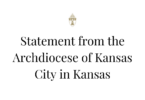
Archbishop Joseph F. Naumann, along with Joel DeRouchey and Richard Weixelman, throw out the ceremonial first shovelfuls of dirt on Nov. 2 during a groundbreaking ceremony for an addition to St. Bernard Church in Wamego. DeRouchey and Weixelman both sit on the parish’s building committee, with Weixelman serving as chair. The 21,341-square-foot addition is Phase II of a capital campaign and master building plan.
by Marc and Julie Anderson
mjanderson@theleaven.org
WAMEGO — A master plan. A transfer of heritage. A totally new facility at a new location.
Those are just a few of the phrases used by St. Bernard’s parishioners to describe their efforts in the past several years to plan for the future by embarking on a capital campaign to fund a new church, an administrative/faith formation building and, finally, a rectory.
Richard Weixelman, chair of the building committee, first coined the phrase “a transfer of heritage” several years ago when the parish began planning for and building its new church.
“I like to use the term ‘a transfer of heritage’ because that’s really what we’ve done here,” he said, referring to how elements of the parish’s older buildings are being used in the new facilities. For example, some of the former church’s stained glass and stonework will be used in the parish hall.
“So, we’re really just transferring heritage from one place to another,” he said.
The new administrative/faith formation building is the second phase of the parish’s multiyear capital campaign and master plan. Expected to cost around $2.8 million and be completed in May 2015, the 21,341-square-foot addition will add administrative offices, a parish hall, classrooms, meeting rooms and a youth room. Also included is a kitchen with more than 1,000 square feet of space.
“We definitely have a vision,” Weixelman said, adding that the intent is to tie both the church and the new formation center together as well as a future rectory, making it appear as if the complex was built at the same time instead of in stages. Although not necessarily intentional, the parish hired the same general contractor and architectural firm used for the building of its church. This, too, according to church members, will aid in creating a seamless look for the parish’s facilities.
Greg Dekat, another member of the committee as well as a finance council member, said the contractor and architect were hired as a team. In fact, the parish hired them both on the same day.
“We’ve just had a fantastic group of people to work with,” Dekat said.
Planning for this second phase began in May 2010, just a few months prior to the church’s dedication on Aug. 22. More recently, the parish finalized the sale of its property in July 2013.
As result of the sale, the parish finally had the remaining necessary funds to move forward with the next steps.
With at least 50 percent of the project’s total cost on hand in the form of assets — including cash and property — and the remainder in the form of pledges, the parish of nearly 400 families began excavation and foundation work in early August.
The ceremonial groundbreaking ceremony came after Mass on Nov. 2 when Archbishop Joseph F. Naumann joined the parish, along with other building committee members and pastor, Father Michael Peterson, in tossing the first shovelfuls of dirt.
Prior to breaking ground, the archbishop blessed the ground with holy water and prayed for the project’s completion, as well as for all of those lives who will be impacted in some way as they use the future facilities. The archbishop also complimented parishioners on the many sacrifices they’ve made to achieve so much progress in a relatively short time.
In his homily, the archbishop discussed the significance of Nov. 2 on the liturgical calendar. Known as the Commemoration of All Souls, the day is set aside by the church to remind Catholics of their true calling to eternal life in heaven. Priests, the archbishop said, are privileged to accompany the faithful as they approach death. They are able to share the hope of the resurrection with those entrusted to their pastoral care, reminding them that “the horizon for the Christian is not confined to the boundaries of this world.”
All Souls falls one day after All Saints’ Day, and, as the archbishop explained, saints are not only those who are officially canonized by the church but can also include parents, grandparents, great-grandparents and others who came before us who are now a part of “a great cloud of witnesses” (Heb 12:1).
Although Catholics ask the saints to pray for those here on earth, said the archbishop, All Souls reminds the faithful on earth to pray for those in purgatory, who have not yet experienced the vision of heaven.
It also reminds us, the archbishop said, “Our prayer group is not confined to the limits of this world.”
Most importantly though, the two feasts together, the archbishop said, remind the Catholic faithful that just a like track star or a jockey who concentrates on running toward a particular finish line, the finish line for the Christian is “not in this world” but, rather, eternal life.






